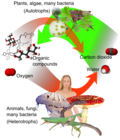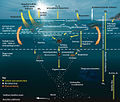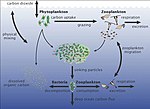The chemotroph designation is in contrast to phototrophs, which use photons. Chemotrophs can be either autotrophic or heterotrophic. Chemotrophs can be...
9 KB (829 words) - 02:51, 16 May 2024
they will then fuse together for reproduction, and form another fungus. Chemotroph Micro-animals Microorganism "NOAA. ACE Basin National Estuarine Research...
5 KB (557 words) - 13:42, 14 August 2024
Productivity Resource Restoration Producers Autotrophs Chemosynthesis Chemotrophs Foundation species Kinetotrophs Mixotrophs Myco-heterotrophy Mycotroph...
128 KB (13,123 words) - 15:10, 23 August 2024
marine primary producers are specialised bacteria and archaea which are chemotrophs, making their own food by gathering around hydrothermal vents and cold...
304 KB (29,027 words) - 19:28, 21 August 2024
substrates. Whereas phototrophs convert sunlight to chemical energy, chemotrophs depend on redox reactions that involve the transfer of electrons from...
113 KB (12,408 words) - 18:04, 20 August 2024
near these volcanoes, and some support peculiar ecosystems based on chemotrophs feeding on dissolved minerals. Over time, the formations created by submarine...
89 KB (9,963 words) - 22:24, 27 August 2024
flagella (all around the cell body, allowing them to move). They are chemotrophs, obtaining their energy from oxidation and reduction reactions, using...
70 KB (8,162 words) - 00:40, 13 August 2024
acids and oligopeptides across its cell membrane. This bacterium is a chemotroph—it performs chemosynthesis to obtain food. However, since its range of...
15 KB (1,792 words) - 14:25, 6 July 2024
are used as bioremediation and biodegradation agents.[citation needed] Chemotroph Extremophile Heterotroph Lithoautotroph Horikoshi, Koki (2010) Extremophiles...
3 KB (232 words) - 22:32, 18 July 2024
electron donor to a terminal electron acceptor in a redox reaction. Chemotrophs are further divided by the types of compounds they use to transfer electrons...
143 KB (15,531 words) - 19:34, 31 July 2024
energy from inorganic compounds such as sulfur or ammonia (they are chemotrophs). These include nitrifiers, methanogens and anaerobic methane oxidisers...
156 KB (16,493 words) - 15:57, 9 August 2024
and carnivorous plants. Phototrophs obtain energy from light, while chemotrophs obtain energy by consuming chemical energy from matter. Organotrophs...
36 KB (4,031 words) - 07:45, 25 July 2024
as photoautotrophs, and can fix carbon. They can be contrasted with chemotrophs that obtain their energy by the oxidation of electron donors in their...
8 KB (740 words) - 06:42, 16 August 2024
assigning them as chemotrophs or phototrophs. Phototrophs utilize light to obtain energy and carry out metabolic processes, whereas chemotrophs use the energy...
28 KB (2,963 words) - 13:47, 23 August 2024
it has recently been discovered that there are some forms of life, chemotrophs, that appear to gain all their metabolic energy from chemosynthesis driven...
18 KB (2,039 words) - 16:50, 27 August 2024
absorb light in photoreceptors and transform it into chemical energy. Chemotrophs release chemical energy. The freed energy is stored as potential energy...
19 KB (1,636 words) - 13:31, 17 June 2024
Productivity Resource Restoration Producers Autotrophs Chemosynthesis Chemotrophs Foundation species Kinetotrophs Mixotrophs Myco-heterotrophy Mycotroph...
31 KB (3,540 words) - 09:27, 13 July 2024
autotrophic producers, but those that oxidize CH3COO− are classed as chemotroph instead. The digestive tract of animals is characterized by a nutrient-rich...
68 KB (7,444 words) - 11:00, 21 August 2024
Energy source Carbon source Chemotroph Phototroph Autotroph Chemoautotroph Photoautotroph Heterotroph Chemoheterotroph Photoheterotroph...
20 KB (2,148 words) - 06:42, 16 August 2024
Productivity Resource Restoration Producers Autotrophs Chemosynthesis Chemotrophs Foundation species Kinetotrophs Mixotrophs Myco-heterotrophy Mycotroph...
84 KB (8,765 words) - 23:53, 26 August 2024
Productivity Resource Restoration Producers Autotrophs Chemosynthesis Chemotrophs Foundation species Kinetotrophs Mixotrophs Myco-heterotrophy Mycotroph...
158 KB (16,553 words) - 06:38, 16 August 2024
(phototroph and photoautotroph) or the energy in inorganic chemical compounds (chemotrophs or chemolithotrophs) to build organic molecules, which is usually accumulated...
19 KB (2,043 words) - 08:28, 7 July 2024
of Gram-positive bacteria related to Clostridium. They are anaerobic chemotrophs and are unusual spore-formers as they produce more than one spore per...
2 KB (121 words) - 07:02, 2 April 2022
serpentinization are released at these vents and provide energy sources for deep sea chemotroph microorganisms. Olivine is a solid solution of forsterite, the magnesium...
30 KB (3,139 words) - 20:16, 5 January 2024
Productivity Resource Restoration Producers Autotrophs Chemosynthesis Chemotrophs Foundation species Kinetotrophs Mixotrophs Myco-heterotrophy Mycotroph...
22 KB (2,276 words) - 10:09, 13 July 2024
with minimal light for photosynthesis. Kinetotrophs could descend from chemotrophs, and have been hypothesized to take the form of sedentary ciliates and...
4 KB (471 words) - 06:40, 16 August 2024
of organisms in cold seeps and the deep sea in general. Oceans portal Chemotroph Gas hydrate pingo Guaymas Basin This article incorporates a public domain...
93 KB (10,615 words) - 20:48, 1 May 2024
marine primary producers are specialised bacteria and archaea which are chemotrophs, making their own food by gathering around hydrothermal vents and cold...
232 KB (21,388 words) - 09:31, 2 June 2024
Productivity Resource Restoration Producers Autotrophs Chemosynthesis Chemotrophs Foundation species Kinetotrophs Mixotrophs Myco-heterotrophy Mycotroph...
13 KB (1,391 words) - 17:53, 31 December 2023
(13,000 to 20,000 ft). The only organisms that inhabit this zone are chemotrophs and predators that can withstand immense pressures, sometimes as high...
37 KB (4,719 words) - 13:56, 11 August 2024




















